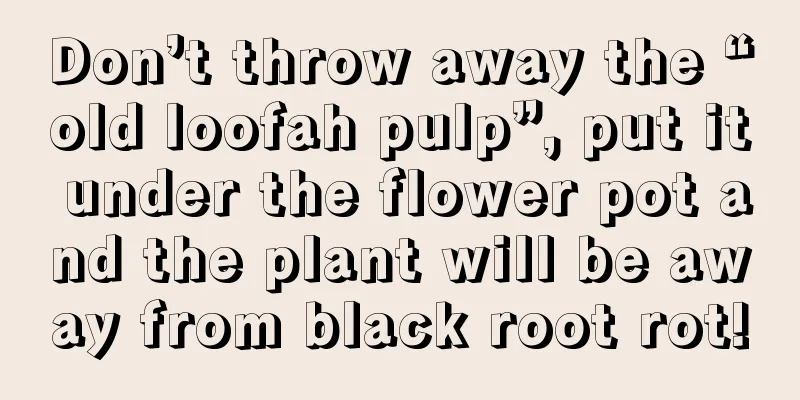Don’t throw away the flower stems of succulents that you pinch off. They will 100% survive if you plant them in the soil!

The flower sword is inserted into the soil, and new buds are growingThe flower sword absorbs a lot of nutrients from the succulent mother plant. Once inserted into the soil, the survival rate is 100%. It grows roots and produces fat side buds! 1. The flower swords of Crassulaceae fleshy plants are suitable for cuttingsNot all flower stems of succulents can be propagated by cuttings, but most flower stems of Crassulaceae succulents can be propagated by cuttings, such as Ceropegia cochinchinensis, Ceropegia serrata, and Ceropegia serrata. 2. Cut off the flower sword and dry the woundFind a pair of sterilized scissors, cut off the flower stem, and place it in a cool and ventilated place to dry the wound. There must be leaves growing on the flower stem so that new buds can sprout from the leaf veins. If the flower stem blooms, the flowers must be pinched off to reduce nutrient consumption. 3. Insert the flower sword into the soilThe soil can be a mixture of river sand, vermiculite, and pine needle soil. First, pour some soil into the soil to make it slightly moist, then insert the flower sword. Don't insert it too deep, just let the flower sword stand steadily, and finally move it under scattered light. 4. New shoots will appear in 15-30 daysIf the soil is dry, water it lightly to keep it slightly moist. Generally, after about 15 to 30 days, new buds will emerge from the leaf veins. The flower sword will take root relatively quickly, usually in about 2 weeks. Pinch off the flower heads and let the side buds sproutIf you pinch off the flower heads of the flower sword, new side buds may grow, which is really a surprise. If you don’t believe me, come and see! 1. Suitable for succulent plants such as Crassulaceae and HaworthiaThe method of pinching off the flower heads and allowing new side buds to grow from the flower stems can be used for succulents such as Crassulaceae and Haworthia. If you grow these two types of succulents at home, don’t throw away the flower swords! 2. Pinch off the flower headsWhen pinching the flower heads, try to choose the lower part of the flower stem and keep three or four leaves at the lower position, so as to leave a growth point for the side buds. 3. The side buds that look like fat balls burst outAfter the flower head of the Crassulaceae Moonlight Goddess was pinched off, it actually grew full-color side buds, which was a big surprise! There is also the Sedum sempervivum, which has also sprouted cute side buds! Break off the small leaves on the flower stem and throw them into the soil, they are guaranteed to survive!Since a lot of nutrients have accumulated on the flower stem, although the leaves on it are very small, they must be very nutritious. If you break them off and throw them into the soil, they will surely grow rapidly! 1. Break off the leaves and dry themUse your hands to break off the small leaves on the flower stem and place them in a cool and ventilated place to dry the wounds. 2. Leaves inserted into the soilPrepare clean and sterilized river sand, pour some water on it to keep it moist, insert the leaves with dried wounds into the sand, and place it under scattered light. 3. New shoots will grow in about 20-30 daysWhen the river sand is dry, add some water to make it slightly moist. Generally, small sprouts will emerge in about 20-30 days. Use flower swords to cultivate new varieties of succulents!Flower lovers can also use flower swords to artificially pollinate succulents, allowing them to produce seeds and cultivate new varieties. 1. Prepare two succulents that bloom at the same timeIf you want to cultivate a new variety, you must first ensure that there are two succulent plants blooming at the same time, so that cross-pollination can occur. 2. Distinguish stamens and pistilsBefore artificially pollinating succulents, you must first clearly identify the stamens and pistils. 3. Remove the stamens of the two succulent plantsPull out the stamens of the two succulent plants by gently pinching them off with tweezers, being careful not to touch the pistil in the middle. Place the plucked stamens on a plate and mark which succulent plant they belong to. 4. Artificial pollinationCross-pollination is to be carried out here, with the stamens of the first plant touching the pistils of the second plant, and the stamens of the second plant touching the pistils of the first plant. You can contact them more often to increase the success rate of artificial pollination. 5. Record information on hybrid pollinationWrite on a small piece of paper which succulent is the female plant and which is the male plant, and tie it to the pollinated flower. The female parent provides the ovary, which is the pistil during pollination, and the male parent provides the pollen, which is the stamen during pollination. 6. Seed maturityAfter artificial pollination is completed, just wait patiently for the seeds to grow and mature. When the seed pod cracks and you can see the seeds, it means it is ripe. You can put a small basin underneath to record the fallen seeds. Have your succulents grown flower stems? If there is a flower sword, Just try the method Huahua said! I think what Huahua said is useful. Just share it with others! |
<<: When is the best time to sow cosmos?
Recommend
Corn planting and harvesting time
Corn planting time Corn is suitable for planting ...
What flowers are suitable for growing in Shanghai? What are the city flowers and trees?
1. Shanghai's Climate Characteristics Shangha...
When is the best time to plant cucumbers?
What month is suitable for planting cucumbers? Cu...
What vegetables are suitable to grow around the Dragon Boat Festival?
What vegetables are suitable to grow around the D...
Does Bear Paw like the sun?
Bear's Paw likes the sun Bear's Paw likes...
How can a ewe produce milk quickly if she has no milk?
If a ewe does not have enough milk after giving b...
Radish planting time and method Planting technology and cultivation time
Radish planting time There are many varieties of ...
"Succulent heartbreaking comparison chart" Xiaoqing VS Shamatte
Meaty Killing Matt Succulent growth How can frien...
Can Monstera be hydroponically cultivated? Methods and precautions for hydroponics
Can Monstera be hydroponically cultivated? Monste...
Blackberry growing conditions and climate requirements for growing areas
Blackberry Growing Conditions Blackberry has a wi...
Will succulents die if they are not watered for a month?
1. Will I die? It will not die if it is not water...
Cultivation methods and precautions of Ficus microcarpa
The golden fig has one leaf with multiple colors ...
What are the effects and functions of dragon bone flower and what are the taboos
1. The efficacy and function of dragon bone flowe...
Lithops cultivation method and watering
Lithops , belonging to the genus Lithops in the f...
How much does it cost to invest in a strawberry greenhouse? What is the construction price and cost of a strawberry greenhouse per acre?
The cost of growing one acre of greenhouse strawb...









